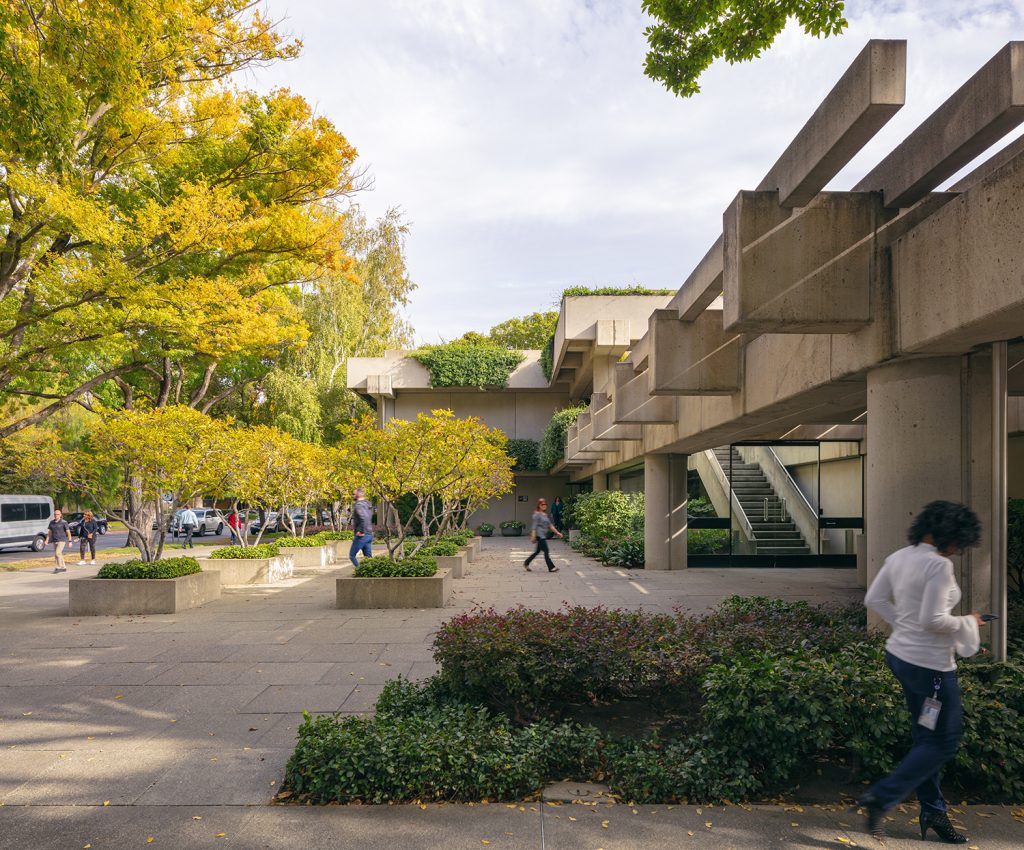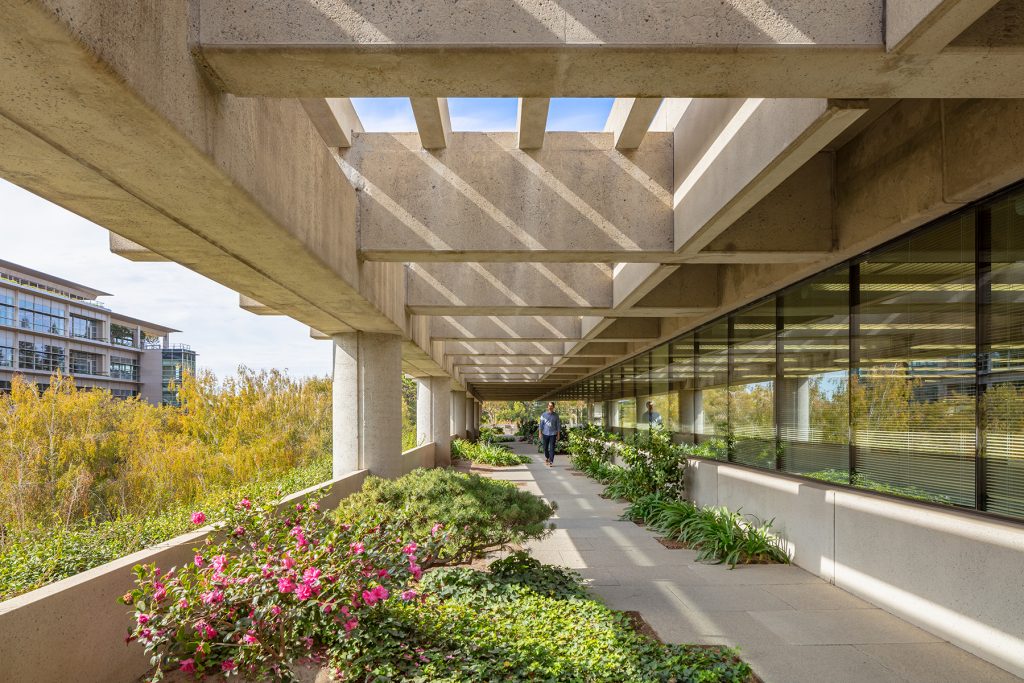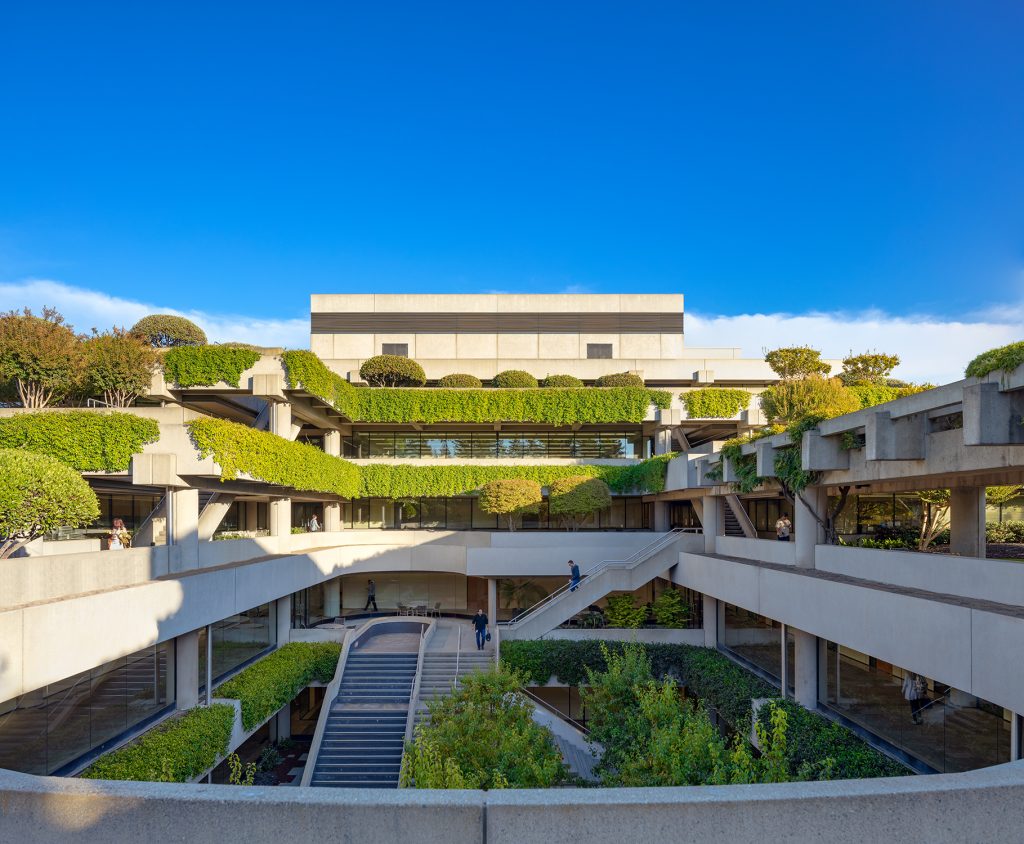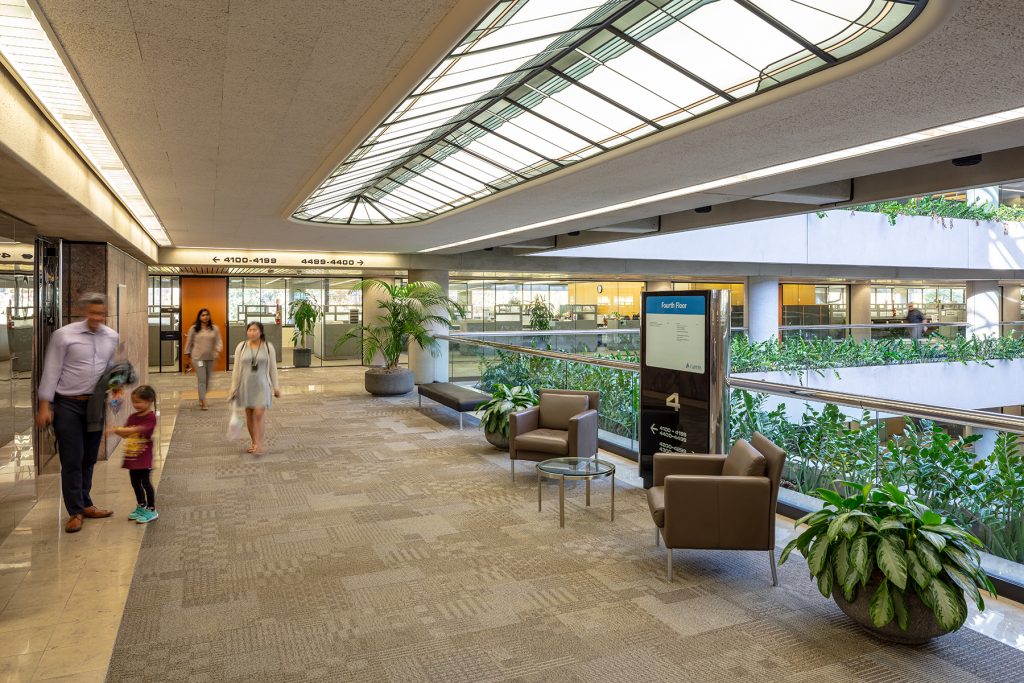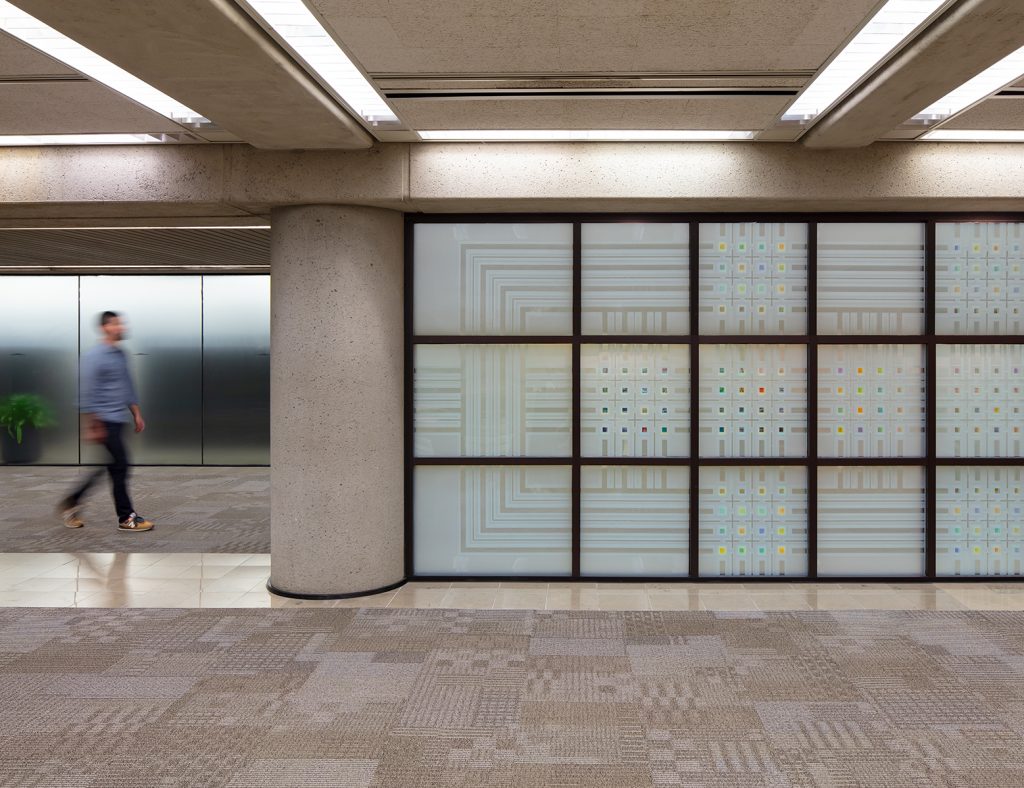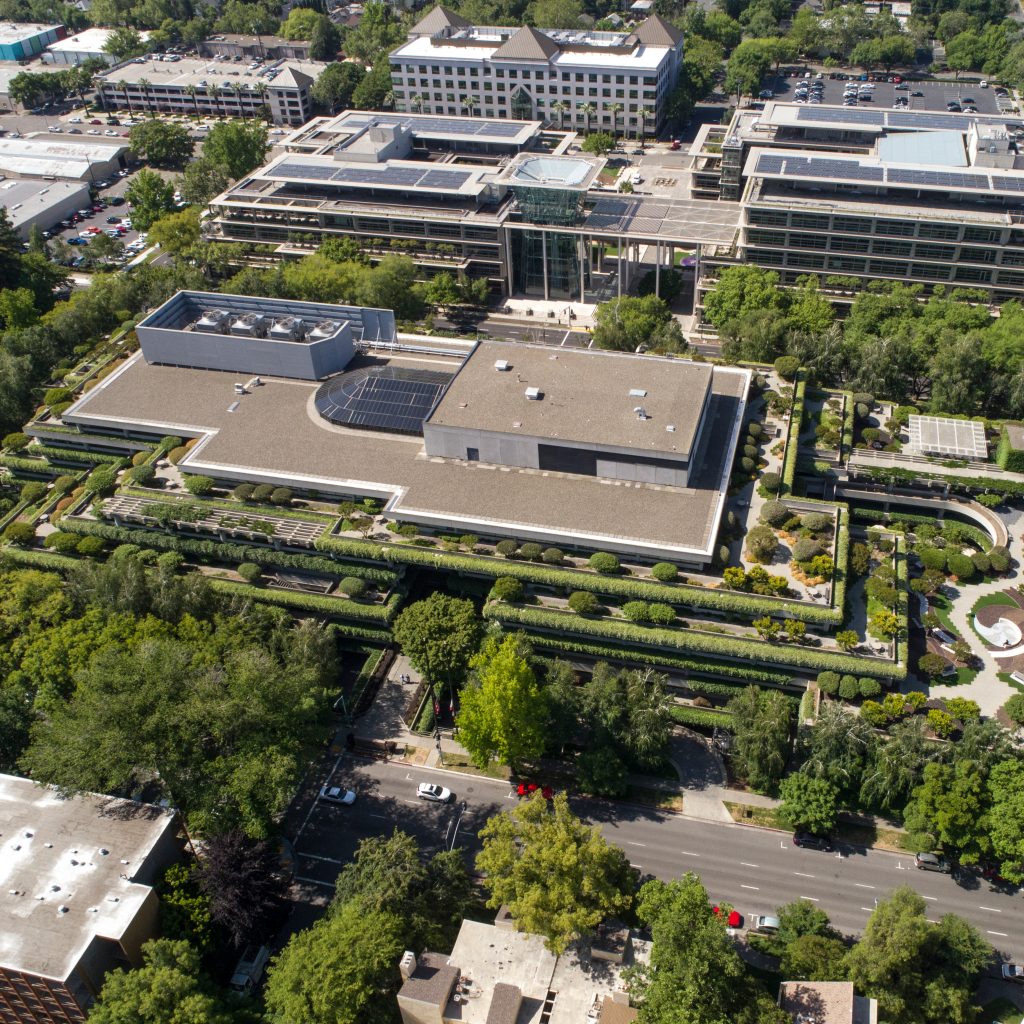Hanging Gardens of Sacramento
January 22, 2013
From the January 2013 issue of
Architectural Review.
by Etienne Louw
Two office buildings in Sacramento, California. The Bateson Building, completed in 1978, and Lincoln Plaza in 1986 take different approaches to environmental concerns, using concrete, organic materials and an unusual air-conditioning system.
In response to the oil crisis of the 1970s, California established a set of energy-efficiency standards for buildings, and architects began experimenting with low-energy buildings starting at a residential scale. Sim Van der Ryn was a pioneer in this ‘green design’ movement, and when he was appointed California State Architect in 1975, an opportunity to take these ideas to a larger public was presented. Van der Ryn and his boss, Governor Jerry Brown were admirers of Gregory Bateson’s Steps to an Ecology of Mind and EF Schumacher’s Small is Beautiful (both published in the early ’70s). Van der Ryn was also significantly influenced by the Integral theorists.
The first large-scale building to embody what we now call sustainable architecture was a state office building in Sacramento completed in 1978, named after Gregory Bateson and designed by a team led by Van der Ryn and Peter Calthorpe. Incorporating ideas radical at the time, in sustainable design circles there has been a vague awareness that its various energy-saving systems were not used for long, although it was unclear why.
Just a couple of blocks away, a less published office building − the Lincoln Plaza Building for CalPERS (The California Public Employees’ Retirement System) − was completed in 1986 by local architectural firm Dreyfuss & Blackford. It employed similar ideas to the Bateson Building, making the two structures ideal subjects for a double revisit.
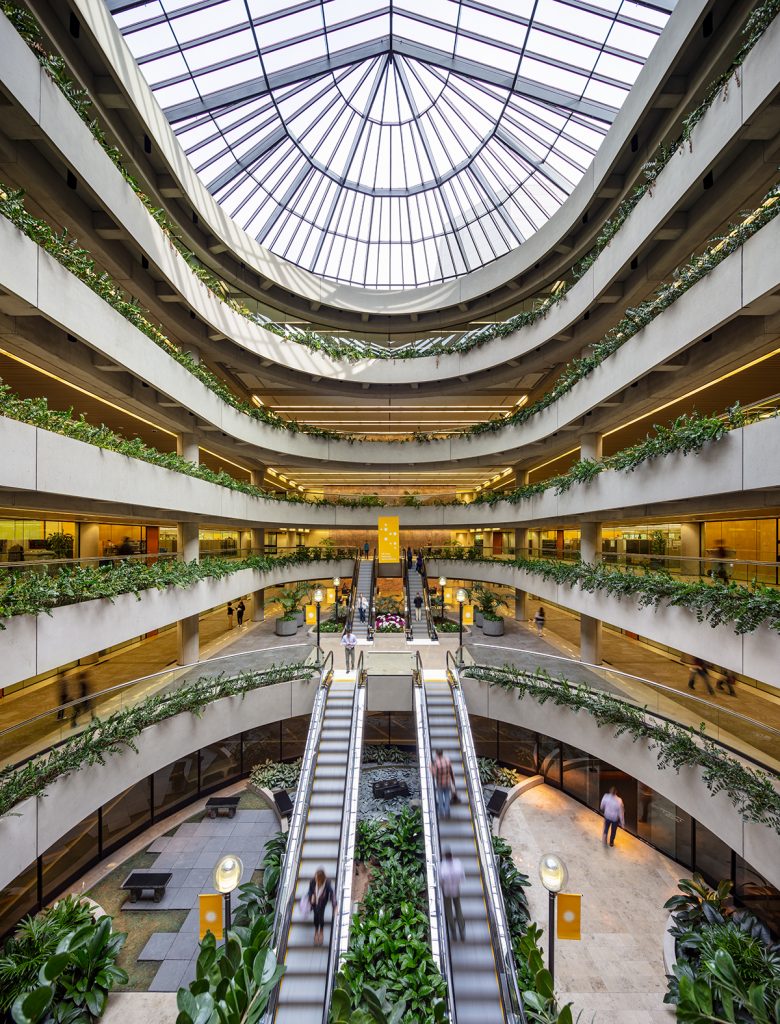
The Lincoln plaza building contains pre-cast planters which create ribbons of foliage both inside and out.
Both had to deal with the specific environmental conditions of Sacramento, which is hot and dry in summer, and has a relatively high water table making subterranean parking deeper than one storey uneconomical. Consequently, the Bateson Building has no on-site parking, Van der Ryn intending the office employees to use public transport instead. Lincoln Plaza, in contrast, has a sunken level of parking reached by ramps with pedestrian bridges providing access at street level.
Both buildings have rectangular plans that effectively fill blocks of the city grid − 25,000 sqm on one city block for Bateson, and 50,000 sqm on two city blocks for Lincoln Plaza − and both are shielded from the streets on all four sides with abundant trees. You could say that they share a similar parti: however, this was arrived at from two contrasting positions.
Similar partis, different departures
It is no coincidence that the building Van der Ryn and Calthorpe designed was named in honour of Gregory Bateson. Bateson championed what he called ‘the pattern that connects man and the natural world’, and Van der Ryn’s primary design aim was a ‘climate responsive’ building that would illustrate the interrelatedness of individuals, societies and ecosystems that Bateson promoted.
In contrast, CalPERS placed more emphasis on the human dimension for Lincoln Plaza. As managers of the state employees’ vast retirement fund, they rely on attracting the best and brightest workforce. The point of departure for Len Blackford was to create the best working environment possible. The client conducted a detailed cost-benefit analysis, which concluded that a five to 15 per cent increase in productivity could be achieved by improving interior environmental factors and the psychological qualities of the individual workspaces. With that goal in mind, Blackford, working closely with departmental heads, concentrated on creating optimal spaces, in both psychological and environmental terms. This ‘from the inside-out’ design approach is clearly evident in the finished structure.
In the Bateson Building, conventional construction elements interact to perform multiple tasks. The building has an exposed concrete lattice-frame structure providing thermal mass to capture, store and release heat internally in winter months. In summer, the structure is purged of heat by the cooler night air to absorb it internally during the day. Within this exposed concrete structure, aluminum-framed window systems and exposed wood spandrel panels fill the grid. In some areas, the structural grid is exposed both vertically and horizontally in the pergolas and outdoor terraces which break up the edges. To illustrate the interrelatedness of systems, Van der Ryn has expressed the essence of the concrete and wood in an unadorned ‘Brutalist’ manner. It is unusual to see exposed wood used so extensively on buildings of this period, and along with the surrounding trees (which are approximately four storeys tall, these panels help the building blend into the streetscape.
The facades are handled differently to address their solar orientation. On the east and west facades, motorised bright yellow canvas shades drop vertically from the horizontal concrete beams to keep early morning and late afternoon sun off the glass. The south facade has a horizontal concrete extension of the lattice structure with closely-spaced concrete beams to reduce the glare of the summer sun, while the north facade is unshaded.
The Lincoln Plaza Building, surrounded by a moat of submerged car parking, is reached by pedestrian bridges on three sides. The west elevation has direct street access to loading docks. Even more so than the Bateson Building, Lincoln Plaza disappears behind a green wall of foliage. This is achieved by a dense screen of trees in conjunction with extensive planting on all levels. Generous five-metre cantilevers provide deep shade to almost every facade, and each cantilever has precast concrete panels fixed to the edge of the slab holding a 450mm-deep planter filled with foliage that cascades over the edges and effectively camouflages the building.
All four facades are handled consistently and, although the depth of cantilever provides a valuable deep recess for sun control, it does inhibit, to some extent, light penetration on the north facade (these cantilevers are also accessible for window and planting maintenance). The deciduous street trees provide additional shade in summer, and allow winter light to penetrate effectively.
The building has a cool and understated elegance. The concrete is well finished and the continuity of the panels provides a horizontality that was commonplace in early ’80s office buildings. These stepped floorplates, and the extensive planted roof decks, elicit comparisons with the work of Arthur Erickson in Vancouver. Erickson called concrete ‘the marble of our time’, and the juxtaposition of concrete and lush planting was regularly seen in his early work. Sacramento has a vastly different climate to Vancouver, and Dreyfuss & Blackford’s Lincoln Plaza is a startling oasis of visual coolness and respite from the hot and dry Sacramento summers.
Energy-efficient ideas
The internal organisation of the two buildings also begins from similar starting points: both have perimeter office space arranged around a central atrium. In the Bateson Building, this is a crucial component of Van der Ryn’s ‘climate responsive building’, with the four-storey unconditioned space acting as ‘the lungs of the building’. It is in the design of the atrium that his energy-efficient ideas are manifested and the integration of systems is played out. The atrium roof has a sawtooth profile with clear glazing on the north-facing incline, and operable vertical louvres facing south.
On the roof, solar panels assist in heating the domestic hot water. General office lighting comprises fluorescent light fixtures placed between acoustic baffles under the concrete soffits, and is supplemented with individual task lighting. Although the building is linked to the state’s central utility plant, which provides steam and chilled water to more than 20 state-owned buildings in downtown Sacramento, the intent was to design a building that would use 80 percent less energy than would ordinarily be the case. This would be achieved by ‘pre-conditioning’ the air by heating it in winter and cooling it in summer by passing it from the atrium over two 600-ton subterranean rock beds located beneath the atrium floor.
At night, air from the atrium would be passed over the rock beds and supplemented and moistened with evaporative spray air washers. In winter, the released thermal mass of the exposed concrete structure together with heat from the central utility plant passed through the rock beds would have the effect of pre-heating the air. In the atrium, vertical canvas tube ducts and fans were installed to prevent stratification by pushing the warm air downwards.
However, in 1976 a mold infestation in an air-conditioning system led to the outbreak of pneumonia at an American Legion convention in Philadelphia and soon acquired the name ‘Legionnaire’s Disease’. In 1978 the State of California opened the Bateson Building, and in 1981, a class-action suit on behalf of State employees who worked in the building was filed. Although no infections could be attributed to the pre-heating and pre-cooling rock bed design, the State deactivated the system soon thereafter, and the building now operates fully off the central-plant piped steam and chilled water system. Reports of occupant discomfort were largely attributable to faulty variable air-volume control boxes that reduced the air supply to occupants. Furthermore, a rushed completion schedule and late installation of fabrics and carpeting containing the irritant formaldehyde caused additional discomfort.
In 2008 the State of California commissioned an infrastructure study which examined the building in considerable detail. It found that the roof-mounted solar water-heating system was removed mainly because of roof load. The report determined that the possibility of mold together with control considerations was the prime reason for the deactivation of the rock bed as a means to pre-heat and pre-cool the air in winter and summer. In addition, the atrium socks were disconnected as the atrium is not heated and there is minimal stratification.
The study concluded that the Bateson Building can be repaired, retrofitted and brought into compliance with current codes together with LEED Silver or Gold certification for existing buildings at 20 percent of replacement cost. In addition, the recommendation includes the reinstallation of the Rock-Bed Thermal Storage System with some modifications. For example, the use of water to cool and add moisture to the air would be eliminated, thereby removing mold concerns. Critically, however, the original design in 1978 was based on a fresh-air ventilation requirement of five cubic feet per minute per occupant, whereas current code requirements are for 15 cubic feet per minute. The atrium cannot be used as a source of fresh air and this increased requirement will increase the heating and cooling loads to be met.
Lincoln Plaza, which covers two city blocks, has double the floor area of the Bateson Building. Its plan is arranged around two major spaces. The first is an enclosed atrium with glazed roof, and the second is an open courtyard adjacent to the cafeteria and auditorium which can also be used as a spill-over space. Overlooking the open courtyard, an extensive outdoor roof garden with significant planting further blurs the relationship between the building and the trees on the street.
While the Bateson’s atrium was intended to play a critical part in the passive heating and cooling of the workspaces, Lincoln Plaza’s designers adopted a different approach to the significant challenges of cooling the building in the summer months. Since the project was located in a predominantly residential area, an early decision was made to minimise external noise from cooling towers and boilers. Consequently, a ground source heat pump system was installed.
The building condenser water system consisted of a single-pass ground-water cooling and heating system from two wells and then re-injected into the aquifer. With ground water at a consistent 18°C, the building could be pre-cooled prior to summer mornings by using only the well water. As the temperature rose, the heat pumps would kick in. In winter, the heat from the computer room equipment was captured and used to augment the heating cycle.
However, because the ground water contained iron bacteria, the filter screens needed cleaning and flushing with chemicals. Since this was an open loop system, the compliance cost for chemical discharge became more onerous. Along with a rise in general maintenance costs, this led to a decision being made − after 22 years of successful operation − to abandon the system and replace it with conventional roof-mounted chillers and boilers. Replacing the open-loop system with a closed-loop system requiring multiple wells would have been a more costly solution.
The thermal mass of the building is significantly increased through extensive landscaping which covers approximately 14,500 sqm, with an annual maintenance cost of approximately $13 per sqm. This allows for significant periods of time during normal operation when a combination of outside air from the heat exchangers and recirculation of inside air can maintain desired temperatures without input from chillers or boilers. The building’s HVAC, pumps, lighting, etc., are controlled by a sophisticated digital energy management system (EMS.) Thermostats are set by the EMS, and occupancy sensors switch lighting off if there is no movement in a particular space, although entrance areas remain lit (after-hours workers can turn on extra lighting as necessary).
Interior workspaces
An occupant survey at the Bateson Building revealed general satisfaction with the work areas. However, thermal control appeared inadequate to more than 50 percent of respondents, and general workspace lighting levels were considered poor by approximately 30 percent of respondents. The survey revealed that a large majority viewed the atrium as a positive feature and that it enjoyed individual and departmental use. In summer it was particularly well used, but in winter a majority found it too cold, with inadequate lighting levels, particularly on cloudy days.
By implementing the Infrastructure Study Report’s recommendations, occupant concerns regarding thermal comfort can be addressed. Some ill-considered interior space planning changes have compromised light penetration from the atrium into surrounding office spaces. When the the motorised blinds are lowered on the east or west facades, natural light is reduced yet further, making the building more reliant on expensive artificial lighting. Fabric blinds that achieve the right balance between light penetration and heat transfer could easily be installed, and general lighting levels can be improved quite simply by painting the concrete soffits which have dulled with age and reduced the intensity of reflected general lighting levels.
In contrast, Lincoln Plaza has benefited from closer attention being paid to employee comfort and flexibility requirements. All office spaces have raised access floors to enhance flexibility, and are used for power, data and telephone networks. Indirect lighting, task lighting, glare-free general lighting, acoustic workstation panels, flexibility in workstation configuration and visual connection to outside light and greenery all contribute to a workspace environment that has consistently received praise from employees.
Hard-walled spaces are located in the internal core of the building, and open office spaces are visually linked to the exterior greenery of the building. Meeting rooms are also confined to the ‘inboard’ edge of the open office spaces, and arranged at right angles to the window wall to maximise external light penetration. Interior office spaces have been well managed and the architects continue to be engaged in designing all changing spatial departmental requirements. Generous outdoor green spaces on each level give employees the opportunity to conduct group meetings, or just to enjoy the surroundings.
This might be a more common approach today, but 30 years ago in the era of utilitarian office space, it was quite far-sighted. It has borne fruit − employees are reluctant to leave the building and relocate to the newer CalPERS building completed a few years ago. There is no doubt that the quality of light, the generosity of outdoor green space and the mature way in which employee needs were addressed, all play a significant role in this respect. Over a period of time, all buildings undergo interior reorganisation of workspaces. Here it is evident that Lincoln Plaza has controlled and managed this aspect very successfully by retaining Dreyfuss & Blackford to design the changes according to the original organising principles. On the other hand, the Bateson Building is subject to different contracting protocols, and continuity in design input is harder to achieve.
In 1978 the Bateson Building cost $80 per sqm. The Lincoln Plaza Building cost $160 per sqm in 1986. But taking inflation into account, the cost of the Bateson in 1986 dollars would be $137 per sqm. The Lincoln Plaza Building has a subterranean basement, extensive landscaping and superior interior finishes. That said the two buildings have very similar basic cost structures.
Through the energy-efficient measures designed at the Bateson Building, Van der Ryn was expecting an 80 percent reduction in energy usage per sqm over 20 to 30 years to pay for the building. The State did not test this hypothesis, and the abrupt deactivation of the Rock-Bed Thermal Storage System enabled critics to rather unfairly dismiss the building’s energy reduction ideas outright, even though they had not been given an adequate chance to prove their viability.
Maintenance and comfort
The limited exterior material palette on both buildings does make ongoing maintenance rather efficient. On the Bateson Building, the only areas where exterior deterioration has occurred are in the sealants between concrete, wood and aluminum, and the waterproofing of outdoor terraces. Modern-day sealants and waterproofing materials are vastly superior to the products around in the ’70s. Notwithstanding these advances, the original materials have stood up well over the 35 years since installation. Despite extensive raised plazas and landscaping on Lincoln Plaza, there have been relatively few waterproofing issues. In fact, the landscaping has largely protected the waterproofing from the degradation associated with heat and sunlight. With almost no direct sunlight on the windows, sealants have held up well.
Both buildings merge into the Sacramento streetscape with an air of easy conviviality. The Bateson Building uses materials − those wood-panelled spandrels − to make the connection between the facades and adjacent trees. Likewise, Lincoln Plaza uses extensive rooftop and edge planting to achieve the blurring of building and street trees, so becoming an integral part of nature.
Besides these similarities, the two designs have a starkly different ethos. The Bateson Building sought to make construction elements ‘multi-functional’, which was a buzzword in the ’70s. For example, the concrete beams act as structure, heat-storer, pergola, and a device from which to hang canvas sunscreens. ‘Energy-flows’ are made evident in the Bateson Building, with the canvas tubes in the atrium drawing immediate attention to an element which has undeniable sculptural qualities and at the same time raises an immediate question as to their function. It does come to mind that the health and comfort of the occupants might have played a secondary role in the resolution of the energy-saving methods attempted.
On the other hand, Len Blackford explained that the design approach on Lincoln Plaza was centred on the individual and the creation of a comfortable workspace. For example, the structural grid was driven by making the spaces relatively column-free for flexibility, but also to ensure that no workspace was far removed from a source of natural light and a visual connection to greenery. The organisation of the plan also provides broad corridors that lead to outdoor rooftop green spaces. Whether it is a visual connection with the outdoor street trees, or access to the abundantly planted roof decks, the natural world is always easily accessible to employees.
Much of the appeal in revisits lies in the opportunity to evaluate original design hypotheses. Unfortunately, the State of California never tested the Bateson’s promise of an 80 percent reduction of energy-consumption. Nevertheless, research done in 2008 means that the Bateson Building is well understood, and recommendations to reactivate the Rock-Bed Thermal Storage System are welcomed. In contrast, no attempt has been made to measure the employee-centric design approach of Lincoln Plaza, which was supposed to lead to a five to 15 percent increase in productivity.
What is evident is that this revisit reveals the Lincoln Plaza Building to be a relatively little-known 1980s masterpiece deserving of wider recognition.

